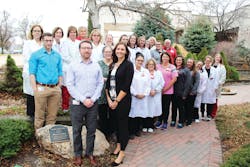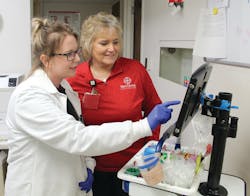2020 Lab of the Year Runner Up: Mary Lanning Healthcare uses Lean Six Sigma approach to boost performance
Mary Lanning Healthcare (MLH) in Hastings, NE, is a regional hospital serving rural communities throughout south central Nebraska.
The 57-employee lab—which was just recertified by the College of American Pathologists (CAP) in 2019—performed 660,110 tests in 2019. The lab’s services include clinical chemistry, hematology, blood bank, microbiology, cytology and anatomic pathology.
In addition to a 170-bed hospital, the lab also supports an affiliated cancer center and more than 20 clinics as well as the region’s critical access hospitals.
Customer Service
To improve customer service, Mary Lanning Healthcare’s lab developed software interfaces, allowing it to transmit results directly from its laboratory information system (LIS) to the electronic systems of external partners, such as independent medical practices, critical access hospitals, nursing homes and pharmacies.
The lab also built an electronic interface with the Nebraska Public Health Laboratory, allowing it to transmit information on antimicrobial sensitivities automatically. The automated reporting process saves technologists four hours per week in time spent re-keying information. It also ensures that the state receives accurate and timely information.
Productivity
Transfusion medicine has been a major focus of the lab’s productivity improvement efforts. In 2019, the laboratory went live with an electronic blood bank system, leading to an 80-percent reduction in paper documentation.
The lab also implemented electronic crossmatches to assess compatibility between donors and patients, reducing the turnaround time per crossmatch from 75 minutes to 45 minutes.* In 2019, 85.8 percent of red blood cells (RBCs) were transfused at a hemoglobin of < 8.0 g/dL, which is a 34 percent improvement from 2015. Only 3.6 percent of RBCs were transfused at a hemoglobin greater than 9.0 g/dL, which is a 61 percent reduction from 2015.
Mary Lanning’s lab launched an education campaign to stop the habit of drawing extra tubes of blood “just in case.” And in 2019, the hospital collected 40 percent fewer extra tubes.
In addition, the size of the collection tube typically used for general chemistry and hematology testing was reduced. Routine blood bank collections were reduced from two 6-milliliter tubes to one tube.
As a result of the blood-drawing initiatives, lab managers estimate that the hospital now saves 4.5 hours per week in phlebotomy time.
In another productivity project, the lab, intensive care unit and emergency department worked collaboratively on a dashboard to track turnaround times of specified STAT lab testing. Since the dashboard went live, benchmark reports are shared weekly between the laboratory and key stakeholders. The laboratory consistently meets or exceeds an established benchmark of 70-80 percent compliance with ICU and emergency department (respectively) turnaround-time metrics.
Teamwork
These efforts have paid off. In an annual standardized survey in 2019, the lab had a mean engagement score of 4.7/5.0 and an accountability score of 4.9/5.0.
Education and training
Mary Lanning Healthcare uses the Lean Six-Sigma problem-solving method, which also is a focus of continuing education at the hospital. The laboratory has five certified Lean Six Sigma greenbelts on staff, with two more likely to earn the distinction in 2020.
Lab managers encourage staff members to earn advanced degrees. “We currently have 12 employees who are actively pursuing an advanced degree of some kind, including phlebotomists who are pre-med, MLTs pursuing their bachelor’s degrees and MTs pursuing master’s degrees,” Adam Horn, MD, pathology/laboratory medical director, wrote in a nomination letter to Medical Laboratory Observer (MLO) for the Lab of the Year Award.
Laboratory Inspections
Mary Lanning uses a paperless document-control system, including an automated system for inspections. The software allows lab employees to link inspection checklist items electronically with supporting documentation. A dashboard displays this information, making it simple to track the work employees do to prepare for an inspection.
In addition, pathology residents launch unannounced partial self-inspections to help simulate a real inspection event.
As a result of this work, the laboratory saw a 60 percent reduction in phase II deficiencies in 2019 compared to 2017. “This externally validates our approach to patient care as one that is quality and safety driven,” Horn wrote.
Strategic Outlook
Auto-validation is a major strategic focus at Mary Lanning Healthcare’s lab. Currently, the lab has 14 chemistry and coagulation tests built to auto-validate. In 2020, lab managers hope to increase the number of auto-validated tests to at least 30 across chemistry, hematology, coagulation and urinalysis.
But the lab also is reaching beyond the walls of the institution. Lab managers are working with a new medical center under construction nearby to decrease send-out referrals, increase local test availability and pool test volumes. The goal is to decrease turnaround times and costs.
*Haemonetics SafeTrace


